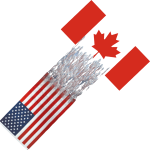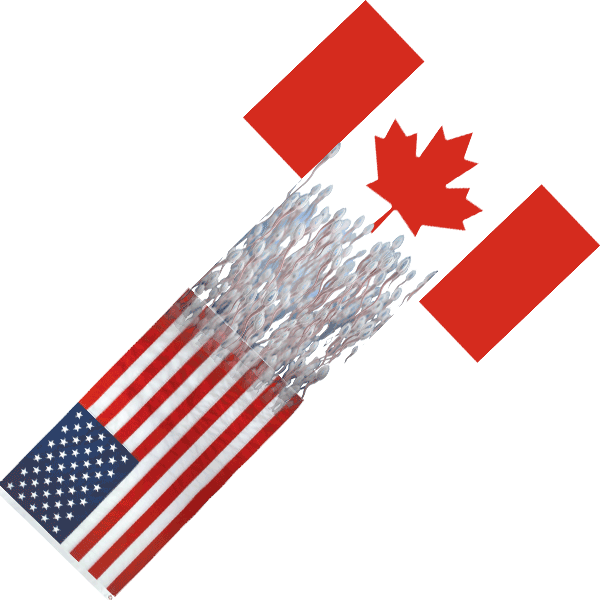Steps for Shipping Horse Semen to Canada from the US
By Jos Mottershead and Kathy St. Martin
It should be noted that while this article about the regulatory aspects of shipping horse semen to Canada from the US is correct at the time of going to press (April 2010, updated December 2020 and June 2023), the regulations may change at any given time. You are therefore advised to confirm currency of all information and forms contained herein with CFIA and/or USDA prior to collection and shipment of semen. This is a guide only and should not be taken as definitive.
Current regulations can be obtained through the Canadian Automated Import Reference System
Shipping horse semen to Canada from the US is not insurmountable with the current regulations – indeed, they are essentially the same as the “old” regulations that were in place before the US/Canadian border opened to semen movement about 20 years ago – but they may prove difficult or impossible for some who want to ship cooled semen because of time-lines.
USDA now has an on-line system for procuring export certificates – the Veterinary Export Health Certification System (VEHCS). US Veterinarians must be enrolled in the system, which is free of charge (the usual certificate costs still apply), and prevents the need for physically attending a USDA office for certificate endorsement. The veterinarian submits to USDA on-line, and some hours later will receive the endorsed certificate back. If the shipping farm has a VEHCS account, the certificate can be forwarded directly to them. They can also make payment for the certificate directly to USDA through the VEHCS account. Details are available at the USDA VEHCS Help Page.
The steps for shipping horse semen to Canada from the US are as follows:
- The Canadian mare owner applies to the Canadian Food Inspection Agency (CFIA) for an import permit. The application can be made on-line via the CFIA semen and animal import page.
- Upon receipt of the import permit, a copy must be sent to the stallion owner/manager to accompany the semen at time of shipment. We recommend getting a multiple-entry permit, even though it is more expensive, as the same permit can be used if the mare fails to become pregnant on the first (or subsequent) shipment. With a single-use permit, a new permit must be obtained (and paid for) prior to a second or subsequent shipment being sent. The copy can accompany the semen shipment, but the original must be available for review by CFIA/CBSA (Canada Border Services Agency – formerly “Canada Customs”) if requested.
- The semen is collected in the presence of a veterinarian certified by USDA-Aphis for the purpose (this is typically your normal vet), and they must obtain a “Zoosanitary Export Certificate for Semen” that certifies as outlined at the foot of this list using VEHCS;
- Once the veterinarian submits the completed certificate to USDA through VEHCS (with a digital copy of the CFIA import permit), and if all is correct, they will have access to the endorsed document a few hours later through the VEHCS website. USDA charge $81 for this endorsement (current at June 3, 2023). If the stallion owner/farm has a VEHCS account, the endorsed document can be made available directly to them for download through their account. Alternatively, the veterinarian may e-mail a copy to the shipping farm, or they may pick up a copy. Note that as the Certificate is signed digitally, there is no requirement for it to be the original;
- A Customs Invoice must be completed and accompany the shipment – they are currently available on-line here;
- Semen presented for importation into Canada must be in individual receptacles or straws, each marked with the collection date, identity of the donor and the semen collection premises;
- Canada Border Services Agency (CBSA aka “Canada Customs”) will also require a copy of the breeding contract;
- If being shipped by courier such as FedEx, it will facilitate the process if they are provided with a power of attorney to act for the mare owner during importation. The form for FedEx along with instructions can be found here;
- Some CBSA import locations may require additional items such as a commercial importer’s number. You are recommended to contact your local CBSA location to determine any additional requirements prior to shipping. This appears to be on an individual location (and possibly CBSA Agent) basis, so is not predictable. If FedEx or another Customs Broker is given broker (Power of Attorney) authorization, they may be able to assist with this;
- The semen is shipped with the accompanying paperwork accessible to authorities for review (i.e. in a suitably marked pouch or envelope on the outside of the container).
 In April of 2009, the requirement that all – including cooled – horse semen shipped to Canada from the US be accompanied by both an import permit and a Zoosanitary Certificate endorsed by USDA was implemented. It was quickly recognized that this presented a problem for many breeders in that time constraints prevented the obtaining of the USDA endorsement before the courier shipment deadline. Hence, many US stallions owners ceased to ship cooled semen to Canada. With the creation of the VEHCS system – which is completed on-line and does not require attendance at a USDA office – this should now not present a problem for most.
In April of 2009, the requirement that all – including cooled – horse semen shipped to Canada from the US be accompanied by both an import permit and a Zoosanitary Certificate endorsed by USDA was implemented. It was quickly recognized that this presented a problem for many breeders in that time constraints prevented the obtaining of the USDA endorsement before the courier shipment deadline. Hence, many US stallions owners ceased to ship cooled semen to Canada. With the creation of the VEHCS system – which is completed on-line and does not require attendance at a USDA office – this should now not present a problem for most.
As can be seen, shipping horse semen to Canada from the US is not difficult, but there are some specific steps that must be completed. If they are not, then the semen will be rejected at the time of inspection by CBSA/CFIA. The requirement for endorsement by USDA-Aphis in particular is the item that may produce time constraints for some with cooled semen shipments if endorsed documents are not returned in time for inclusion with the shipment. Previously, a copy of the endorsed documents along with the import permit could be faxed by USDA to the CFIA import center, however with the development of the digital certification process with VEHCS, this option is no longer available. Obviously frozen semen will permit longer time-delays and presents no problem.
Note that there are NO differences as to the region where the horse is located within the US. Some Internet bulletin board or Facebook posts that we have seen reference the stallion being in a “CEM free zone”, a “State not currently affected” or from a “USDA Certified CEM-Free farm” and that any of those might make a difference. It makes no difference to the import requirements. It is semen from ALL farms and ALL of the USA that must be certified in the manner described! If there are other diseases within the stallion farm’s state or within a certain radius, other requirements may also apply (an example would be Vesicular Stomatitis).
“Zoosanitary Export Certificate for Semen” Declaration wording:
(The wording below in italics is copied from the AIRS system, June 6, 2023 with the following settings for equine semen: origin, Oklahoma; end use, breeding. Use the system to ensure that the wording is the same for your location and usage)
CERTIFICATION
It must be certified that the donor animal(s), from which the germplasm for export to Canada was sourced, have been examined and found to be healthy and free from any clinical evidence of communicable or infectious disease and, as far as can be determined, exposure thereto, during every procedure related to the collection of the germplasm.
The horse semen must be certified as free of Contagious Equine Metritis (CEM) as follows:
Either:
1. The donor horse(s) have not been on a premises where T.equigenitalis has been isolated during the 60 days immediately preceding collection of the semen for export to Canada or a premises currently under quarantine or investigation for CEM.
2. The semen was processed using an extender that contains antibiotics effective against T.equigenitalis.
3. The semen is in individual receptacles or straws, each marked with the collection date, identity of the donor and the semen collection premises.
Or:
The semen was legally imported into the U.S. for unrestricted use.
NOTE: In this case, the country where the semen was collected must be approved by CFIA for the export of equine semen, directly to Canada – Please verify in AIRS by selecting the country of origin.
Originally published by Equine-Reproduction.com 02/18/2009, with updates added 04/27/2009, 05/31/2017, 12/10/2020, 6/3/2023
Reviewed for content currency 04/22/2010, 05/31/2017, 6/3/2023
Current regulations can be obtained through the Canadian Automated Import Reference System
Use “semen” in the commodity search, then “equine (horse)” in the subsequent search field, then answer the questions appropriately.
© 2010, 2020, 2023 Equine-Reproduction.com, LLC
Use of article permitted only upon receipt of required permission and with necessary accreditation.
Please contact us for further details of article use requirements.
Other conditions may apply.



